- Florida’s orange harvest is the lowest since 1947 (Neate, 2016).
- The decline in orange production is caused by a citrus greening disease—huanglongbing (HLB) (Neate, 2016).
- Hurricane Irma exacerbated the issue by reducing orange crops by 21 percent (Bjerga & Perez, 2017).
- The entire industry is in a dire position.
Florida’s citrus industry has experienced a series of devastating blows that have put it on the brink of collapse. Currently, the state’s orange harvest is the lowest since 1947, which can shrink the industry to less than a half of its size (Neate, 2016). According to the US Department of Agriculture (USDA), Hurricane Irma devastated the harvest, thereby reducing orange production by 21 percent (as cited in Bjerga & Perez, 2017). It is estimated that orange farmers in the State of Florida, which is the leading US producer of the fruit, will harvest only 54 million boxes in the 2017-2018 season (Neate, 2016). The plummeting crop production has several causes.
The valuable commodity, which has become an inspiration for the state’s beverage, flower, and song, is a mainstay of agriculture in the region. However, its production has always been associated with numerous struggles such as hurricanes, freezes, periods of frost and competition from a major exporter of oranges—Brazil (“Florida agriculture,” 2016). However, orange producers in the state have encountered an enemy that is more dangerous than weather conditions. The hurdle that has put the entire industry in dire straits is a bacterium that causes a citrus greening disease known as huanglongbing (HLB) (Neate, 2016).
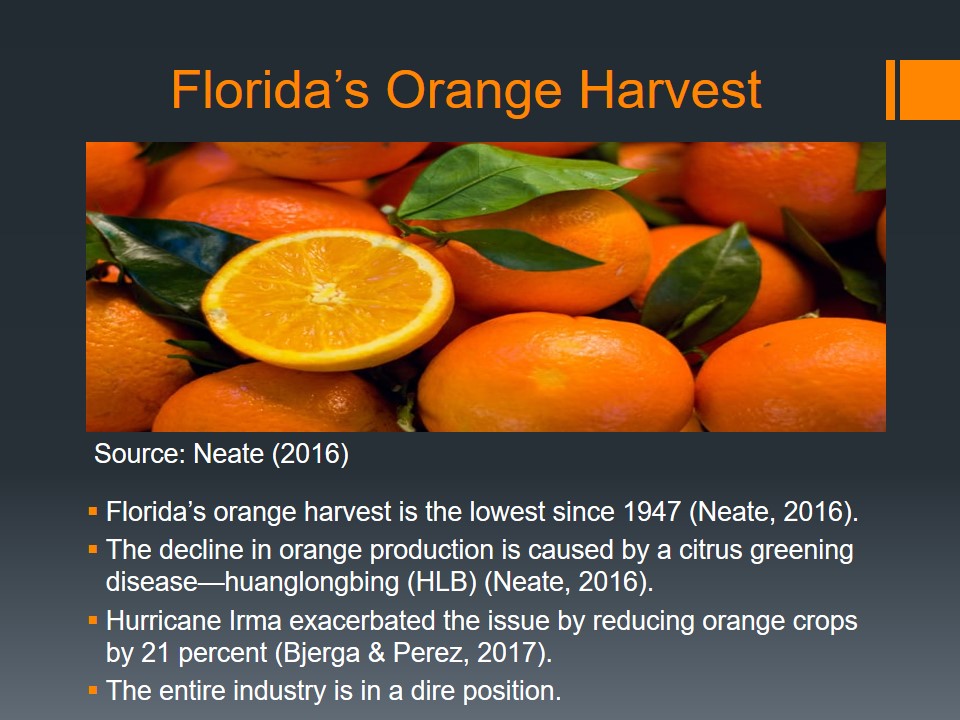
HLB Symptoms
- Citrus HLB originates from Asia.
- The disease is characterized by patchy mottling on the plant’s shoots and leaves (Wang & Trivedi, 2013).
- The progression of HLB is associated with crop reductions and fruit discoloration.
- More than $100 million in research has been directed towards the elimination of the disease (Neate, 2016).
Citrus HLB is a crop disease that has been known in Asia for many decades (Wang & Trivedi, 2013). HLB had been largely ignored by the world community until it was transmitted to the US in 2005 (Neate, 2016; Wang & Trivedi, 2013). The disease that has suddenly become relevant now threatens the existence of the citrus industry in the country.
In terms of symptomatology, HLB is characterized by several effects all of which threaten the life of the plant. The disease produces patchy mottling on shoots and leaves. The infected areas are stunted, which causes gradual tissue deterioration that is concomitant with HLB progression. Fruits produced by affected orange trees are usually disfigured and discolored. It has to do with the fact that fruits from healthy citrus trees start developing their signature orange color at the stylar end first, whereas peduncular end remains green (Wang & Trivedi, 2013). The process is reversed on HLB-affected oranges, which often causes oranges to drop before harvest (Wang & Trivedi, 2013). The affected trees are also characterized by excessive leaf loss that results from the alteration of normal root function. The qualitative and quantitative reduction of crop yields has led to a steep price increase of orange-derived products. Therefore, orange farmers have invested more than $100 million in research to combat the progression of HLB (Neate, 2016).
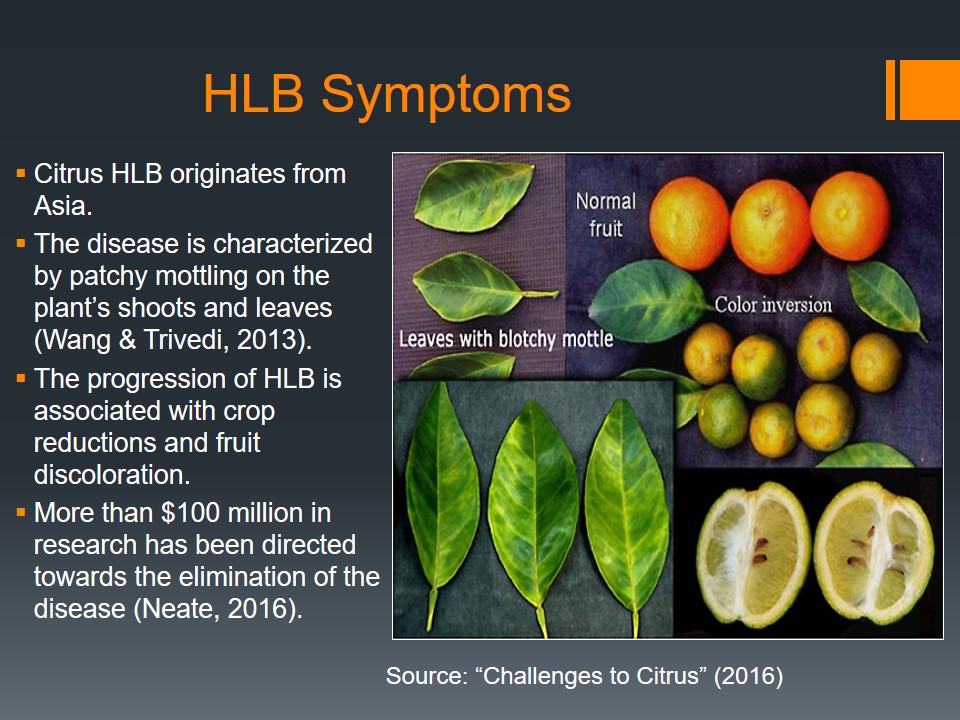
Management of HLB
- HLB is transmitted by the Asian citrus psyllid (ACP).
- The management of the disease falls into two categories: chemical control of ACP and chemical control of HLB (Feely, 2016).
- The chemical control of the condition is associated with an ethical dilemma.
HLB is extremely hard to manage; therefore, the production of orange crops in affected areas is expensive (Feely, 2016). The disease is transmitted by the Asian citrus psyllid (ACP), which, in addition to spreading the infection, causes indirect damages to orange trees. According to Boina & Bloomquist (2015), the damages are caused by “heavy ingestion of phloem sap by adults and nymphs and injection of toxins through saliva” (p. 808). The psyllid is the disease vector of the HLB-causing pathogen—Candidatus Liberibacter asiaticus (Boina & Bloomquist, 2015). After psyllids have been established in a region the control of the disease is reduced to the management of their population. High reproduction rates of the insect make the task extremely difficult.
The approaches to the management of the condition can be divided into two categories: chemical control of ACP population and chemical control of HLB transmission (Feely, 2016). Chemical control of ACP is performed through the foliar, soil, and trunk application of insecticides (Feely, 2016). The chemical agents affect the psyllid’s nervous system, which causes a rapid death. Due to a high frequency of the insect’s flushing patterns, farmers use a high volume of insecticides that drench the soil underneath orange trees. Soil application further exacerbates the issue of chemical pollution. Chemical control of HLB is conducted with the help of trunk-injected antibiotics (Boina & Bloomquist, 2015). This method of control presupposes frequent intervention, which increases the change of Candidatus Liberibacter asiaticus developing resistance to antibiotics (Boina & Bloomquist, 2015).
Unfortunately, the agricultural use of insecticides is associated with numerous ecological consequences. It has to do with the fact that insecticides are “highly biologically active substances that can threaten the ecological integrity of aquatic and terrestrial ecosystems” (Stehle & Schulz, 2015, p. 5750). The expansion of agricultural capacities in the Western world has led to the increase in insecticide use by 750 percent in the period from 1955 to 2000 (Stehle & Schulz, 2015). Despite stringent environmental regulations, insecticides inevitably enter non-target areas.
The exposure of surface waters to dangerous chemical agents is one of the most problematic consequences of the pesticide use. A study conducted by Stehle and Schulz (2015) shows that in more than 50 percent of cases the amount of pesticides in surface waters exceeds threshold levels. Another study shows that the normal ecosystem functioning and resilience are threatened by the pesticide use because it affects microbes and invertebrates that function as decomposers and pollinators (Chagnon et al., 2015). In case of waterbodies, the use of chemical agents damages fish populations who are both consumers and predators. It follows that Florida orange harvest crisis is associated with an ethical dilemma of whether pesticides can be used to save harvests, while simultaneously indiscriminately distinguishing many creatures and endangering the integrity of entire ecosystems.
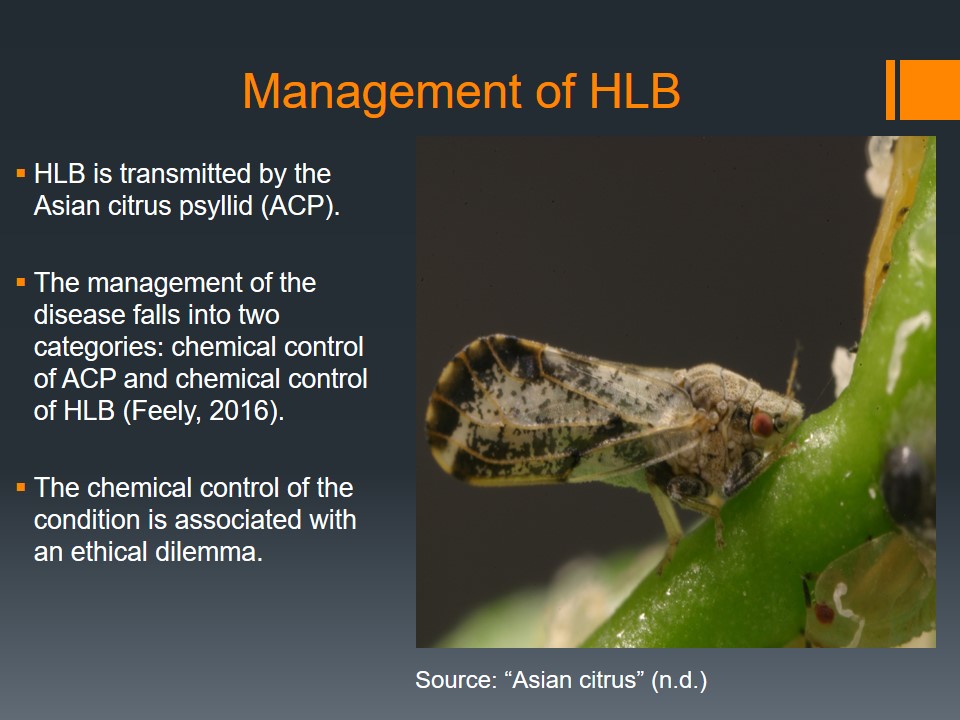
Market Utilitarianism
- Market utilitarianism favors market solutions to ecological problems (Kernohan, 2012).
- Under market utilitarianism, every individual should be left to their own devices.
- Market solutions hinge on the protection of private property rights.
O’Toole and Baxter argue that since every individual should be left to their own devices, environmental problems must be resolved with the help of market solutions (as cited in Desjardins, 2013). It follows that an answer to the ethical dilemma is a proper protection of private property rights, which will stop farmers from polluting the environment.

Critique of Market Utilitarianism
- Basic premises of market utilitarianism are challenged by environmentalists (Desjardins & McCall, 2014).
- The opponents of market solutions for environmental problems claim that they are based on unrealistic assumptions about the nature of the world.
- In the real world, information is much more diffused than in abstract mathematical models.
- Transaction costs are often associated with externalities (Desjardins & McCall, 2014).
Market utilitarianism has always been criticized for its overreliance on mathematical abstractions that do not take into consideration environmental externalities. Diffusion of information is a barrier to effective market-based solutions to the problem of insecticide pollution.
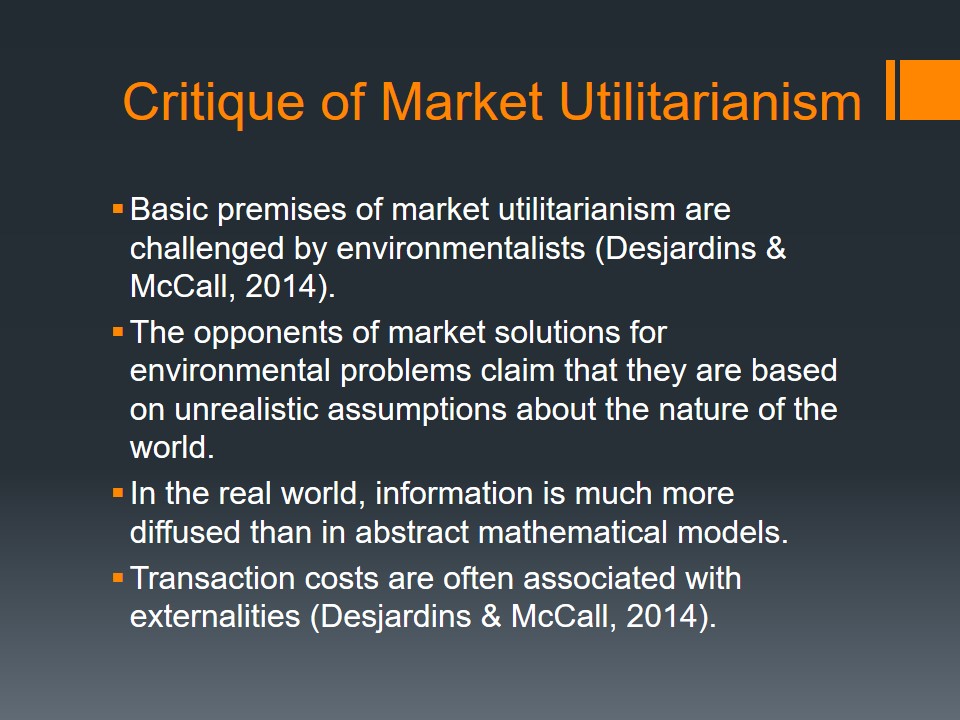
Shallow Ecology
- Shallow ecology presupposes that humans are the only species of value (Fryer, 2014).
- The worldview is inherently anthropocentric.
- The protection of the environment is a means to improving the well-being of humans.
Shallow ecology is a limited outlook on the environment that regards nature as a means to human ends (Fryer, 2014). When viewed from the perspective of shallow ecology, Florida orange harvest crisis has to be addressed in order to farther interests of people who consume fruits. Furthermore, the damages caused by the insecticide pollution might make it difficult to obtain resources in the future. It follows that shallow ecology and market utilitarianism are closely aligned concepts.
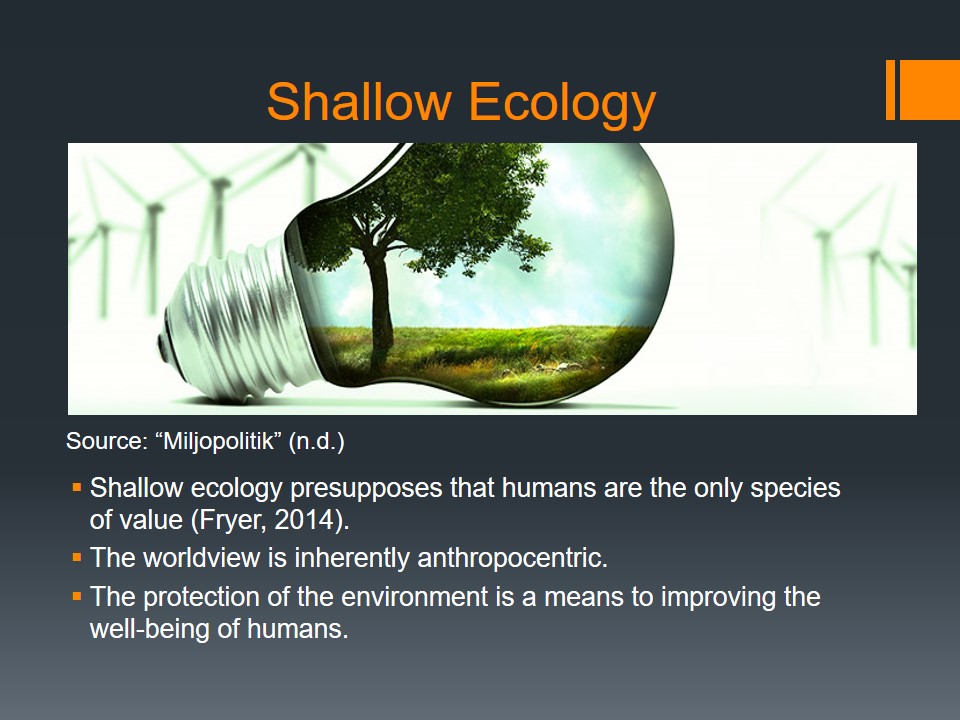
Deep Ecology
- Unlike shallow ecology, deep ecology is a worldview that is concentrated on causes of environmenal issues such as pollution (Desjardins, 2013).
- Deep environmental perspectives are not human-centered. The proponents of the philosophical view argue that nature has intrinsic value; therefore, it is worth protecting for its own sake (Desjardins, 2013).
- In the framework of deep ecology, the use of insecticides is immoral because it harms many species.
- Anthropocentrism is an underlying cause of all ecological problems (Desjardins, 2013).

Key Principles of Deep Ecology
- All nonhuman life-forms are intrinsically valuable.
- It is wrong to measure the value of non-human living organisms against interests of humans (Desjardins, 2013).
- Humans cannot interfere with ecosystems except for satisfaction of their vital needs.
To resolve the ethical conundrum under discussion, a radical approach is needed. Namely, instead of trying to develop less harmful insecticides for controlling ACP populations, it is necessary to change human perception of the environment. People have to realize that in an attempt to increase the production of orange crops they eradicate organisms whose lives are intrinsically valuable.

Biocentric Ethics
- Biocentric ethics are environmental ethics that are characterized by reverence for all life forms (Kernohan, 2012).
- The biocentric outlook presupposes four basic tenets:
- Humans are members of “earth’s community of life” (Desjardins, 2013, p. 141);
- All living organisms are interdependent;
- All life forms pursue their own ends in accordance with the reality of their means;
- Humans are in no way shape or form superior to other living beings.
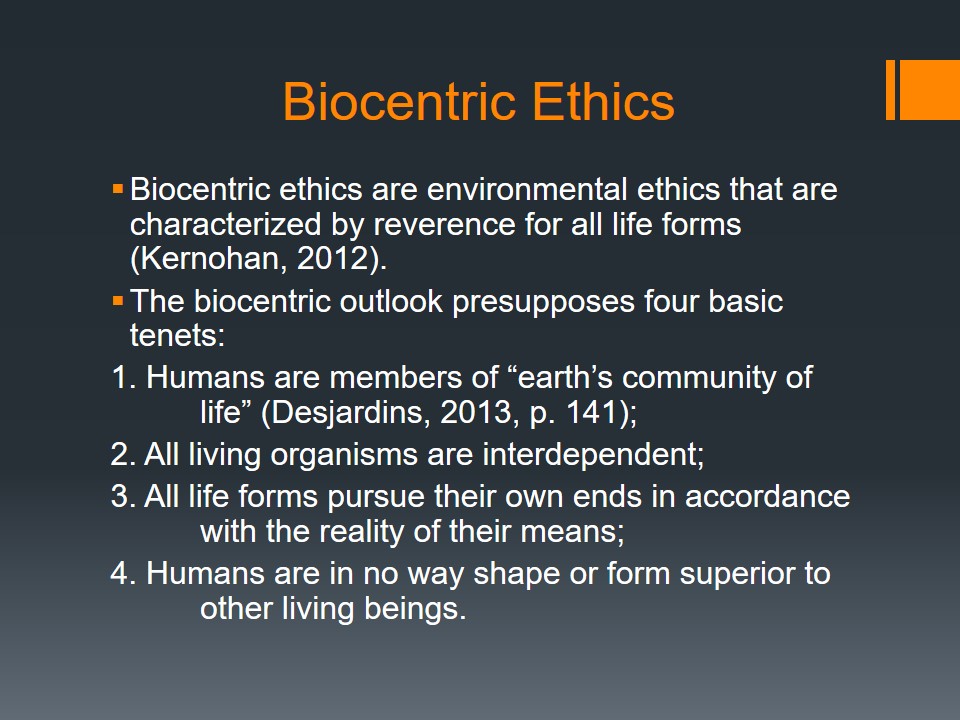
Practical Implications of Biocentric Ethics
With respect to the ethical dilemma, biocentric ethics have the following practical implications:
- With respect to the ethical dilemma, biocentric ethics have the following practical implications:
- The rule of nonmaleficence calls for the discontinuation of harmful farming practices because they threaten living organisms.
- The duty of noninterference demands Florida’s farmers to refrain from misbalancing local ecosystems.
- The rule or restitutive justice necessitates active steps towards the restoration of water resources harmed by chemical pollutants.
Strict adherence to biocentric principles will help to restore Florida’s ecosystems damaged by actions of farmers seeking excessive profits.
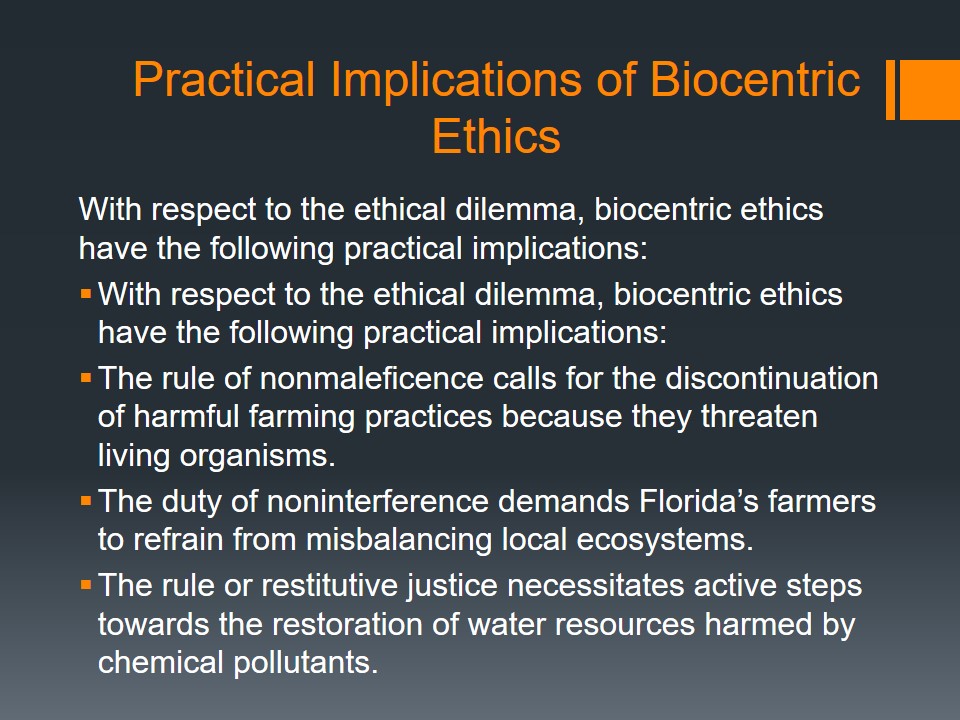
Challenges
The practical application of biocentric ethics to the ethical dilemma is associated with several challenges:
- The current philosophic paradigm promotes human interference in nature because humans are regarded as “separate from nature” (Desjardins, 2013, p. 143);
- Environmental changes are resisted by influential organizations that profit from the status quo;
- The American policy arena is dominated by conservative initiatives that are supported by anthropocentric arguments (Nolt, 2014);
- The American public is, arguably, not progressive enough to espouse biocentric ethics in their entirety.
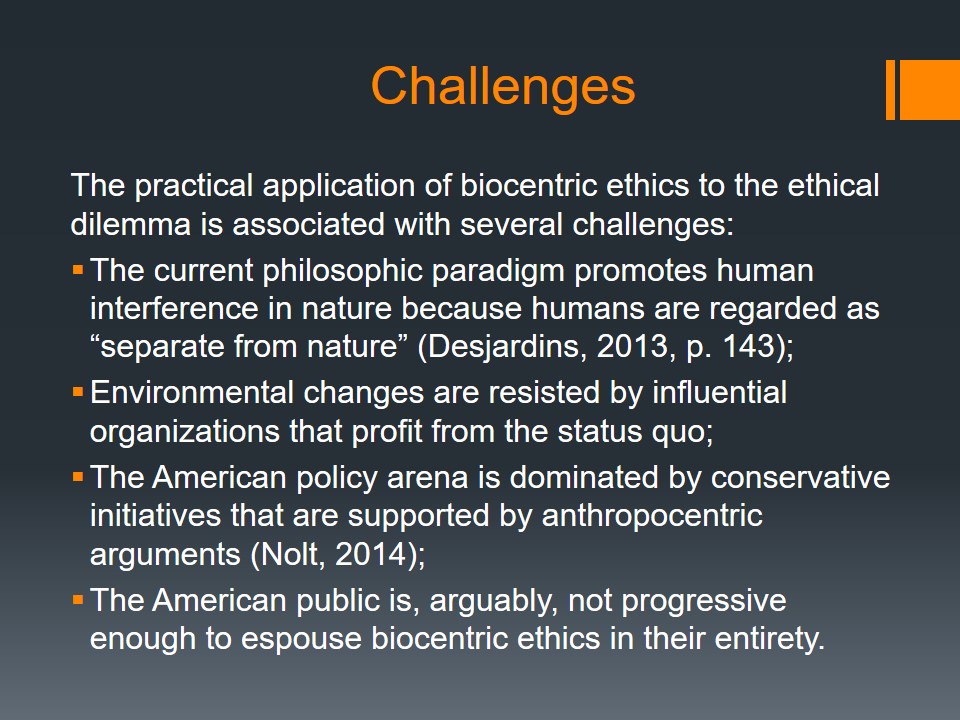
Predictions
- If the rate of the current ACP population growth continues, the state’s farmers will discontinue their operations in several decades.
- Brazilian orange producers will rely on the use of harmful insecticides to increase their production of the commodity.
- The reliance on intrusive farming techniques will result in substantial and possibly irreversible ecological damages.
- The discontinuation of orange production in Florida will push farmers towards other crops the growth of which is also associated with the use of chemicals.
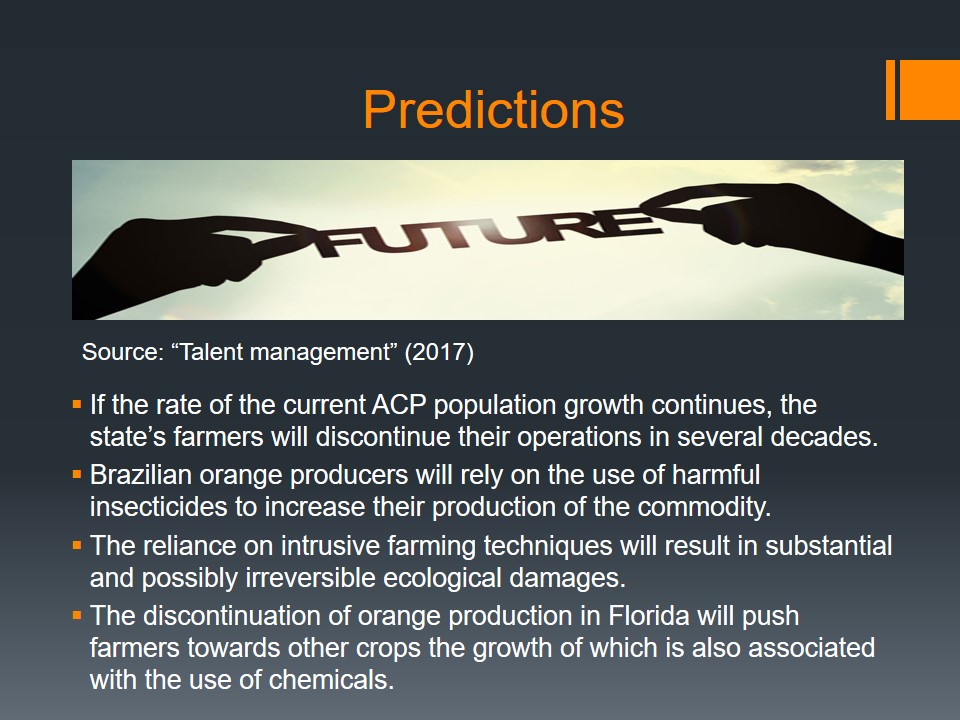
First Solution
- The first ethical solution to the problem is to discontinue harmful farming practices that devastate local ecosystems.
- To this end, it is necessary to conduct a comprehensive political reform.
- To introduce meaningful changes in a legal structure of the state, support of the majority of Florida’s population is needed.
- The support can be achieved by attracting media attention to the problem.
- It is also necessary to initiate street protests and social-media campaigns.
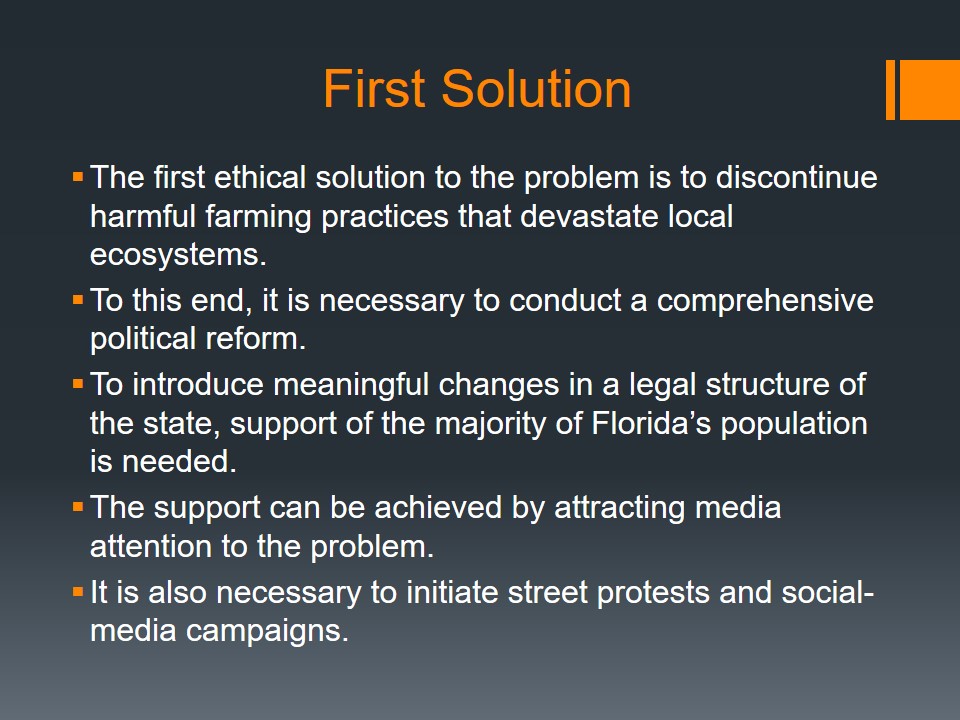
Second Solution
- The second solution will eliminate the need for insecticides, thereby sparing ACP populations and local ecosystems.
- Genetic engineering can produce orange trees that are resistant to HLB, thus making ACPs non-harmful for crops (Feely, 2016).
- Hybrid orange trees can be grown around the world, which will help to reduce chemical pollution in countries such as Brazil.
- In addition to resolving the ethical dimension of the problem, the solution will help to free monetary resources necessary for restitutive justice.

References
Asian citrus psyllid and huanglongbing. (n.d.). Web.
Bjerga, A., & Perez, M. G. (2017). Florida orange crop plunges to 71-7ear low after Hurricane Irma. Bloomberg. Web.
Boina, D. R., & Bloomquist, J. R. (2015). Chemical control of the Asian citrus psyllid and of huanglongbing disease in citrus. Pest Management Science, 71(6), 808-823.
Chagnon, M., Kreutzweiser, D., Mitchell, E. A. D., Morrissey, C. A., Noome, D. A., & Sluijs, J. (2015). Risks of large-scale use of systemic insecticides to ecosystem functioning and services. Environmental Science and Pollution Research, 22(1), 119-134.
Challenges to citrus production. (2010). Web.
Deep ecology. (n.d.). Web.
Desjardins, J. R. (2013). Environmental ethics: An introduction to environmental philosophy (5th ed.). Boston, MA: Cengage Learning.
Desjardins, J. R., & McCall, J. J. (2014). Contemporary issues in business ethics. Boston, MA: Cengage Learning.
Feely, E. (2016). Saving the orange: How to fight citrus greening disease (and it’s not through genetic engineering). William & Mary Environmental Law and Policy Review, 40(3), 893-916.
Florida agriculture industry can’t shake citrus fall, land loss. (2016). Web.
Fryer, M. (2014). Ethics theory and business practice. New York, NY: SAGE.
Kernohan, A. (2012). Environmental ethics: An interactive introduction. Peterborough, Canada: Broadview Press.
Miljopolitik. (n.d.). Web.
Neate, R. (2016). Feeling the squeeze: Florida faces worst orange harvest crisis in a century. The Guardian. Web.
Nolt, J. (2014). Environmental ethics for the long term: An introduction. Abington, England: Routledge.
Stehle, S., & Schulz, R. (2015). Agricultural insecticides threaten surface waters at the global scale. PNAS, 112(18), 5750-5755.
Talent management: predictions for 2017 and beyond. (2017). Web.
Telling right from wrong: Why is utilitarianism under attach? (2014). Web.
Wang, N., & Trivedi, P. (2013). Citrus huanglongbing: A newly relevant disease presents unprecedented challenges. Phytopathology, 103(7), 652-665.